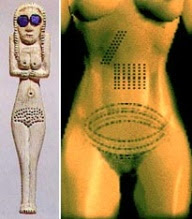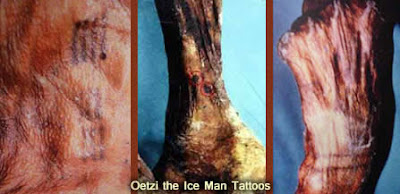Her father-in-law grew up in a close nit family; his father was a preacher and a clock maker. He was very close to his father. Later that same year his father passed away. He had a dream the night his father passed away, in the dream he saw a big grandfathers clock with bright light all around it floating up to heaven . When he awoke he heard the news that his father had passed on. The very next day he went and received a marvellous tattoo of an angel embracing a grandfather’s clock . This made her ask herself; what reasons do people around the world receive tattoos and what is the history behind the act of tattooing? During her research she came to the realization that tattoos are not just rebellious acts of self expression; they have been used for medicinal purposes, in spiritual rituals, and even as a form of punishment.
Tattoos have been around for thousands of years. The science world has accepted previously that the oldest evidence of tattooing was found in Egypt. Specifically tattooed female figurines were found dating back to 3500 B.C. Female’s drawn into tomb scenes and other female figurines were found dating back to 1200 and 1300 B.C With tattoos on their thighs. Additionally discovered were small instruments made of bronze, recognized as tattooing tools, dating back to 1450B.C.
 |
| Ancient Egyptian pregnancy tattoos |
Moreover three female Tattooed mummies were found dating back to 2000B.C, However, the 1991 discovery of Ice Man found around the Italian-Austrian border has pushed the previously mentioned date back another thousand years to around 5200 B.C. In fact, Ice man had 58 separate tattoos.
Accordingly, many of Ice mans tattoos’ were located over arthritic joints; in fact, Ice mans tattoos were mostly groups of parallel lines. Furthermore some of the tattoos were placed in acupuncture locations used for relieving pain, anaesthesia, promoting endurance, and detoxification.
 |
| Oetzi the iceman was found to have 58 separate tattoos |
Additionally, historians believe that the reason that tattoos were only found on women in Ancient Egypt is that tattooing was used as an aid in giving birth. Specifically tattoos were placed largely on the thighs and abdomen and formed in a protective fashion. Equally important, in medicine today doctors sometimes use tattooing in medical procedures.
Tattoos are used in accordance with radiation and re-constructive surgery. For Instance, during radiation therapy for cancer patients a precise target must be hit every time thus the medical professionals sometimes tattoo a target pattern onto the skin so that they know that they are accurately treating the cancer. Additionally, in re-constructive surgery tattoos are used for multiple reasons.
One way that tattoos are used for re-constructive purposes is for colouring in an areola after a mastectomy. A mastectomy is the removal of a breast usually after a diagnosis of breast cancer; this procedure helps the recipient to go on with their lives with a better self image. Another use for tattoos in today’s medical world is to return a person’s skin pigmentation back to its original colour after a burn or genetic disorder. Evidence shows that tattoos may have been used for medicinal purposes dating back to the first tattoos and still continue to be used for this purpose even today.
Although there is striking evidence that early tattoos were used vastly for medicinal purposes, there is also evidence that shows tattoos have played a key role in the spirituality of some cultures throughout history. Statuettes with tattoos representing fertility and rejuvenation were placed in tombs as offerings. Of course in Ancient Egypt sexuality went hand and hand with life. These statuettes were apparently designed to “arouse the sexual instinct of the deceased and to ensure resurrection.”
 |
| Tattooed fertility statuettes |
Additionally, Buddhist Monks dip two prong rods into a dark mixture made with snake venom and repeatedly puncture the skin of followers. The people of this faith believe that this ceremony will cast out demons and keep them from harm. In the same way in Thailand many people believe that tattoos provide one with special powers. Consequently some people believe that a Tattoo will make them immortal. Animal tattoos are used a great deal; the wearer believes that in receiving an animal tattoo they will ascertain some of the animal’s powers. Moreover, Animal tattoos were usually a source for power filling the believer with spirits.
In ancient times some people believed the relationship between inside and outside the skin is the separator between the passions deep within. History tells of a warrior found with tattoos identified as used to promote the supernatural force to take hold of the body during a trance and to stimulate the body and give the person magical powers. This warrior exhibited a pattern of dots tattooed on both sides of his spine as well as his face.
 |
| Warriors often tattooed themselves in intricate "dot" designs |
In modern time’s Christian warriors tattooed crosses on top of their hands to ensure a Christian burial, although, the Bible speaks of one not defiling the temple of the lord by tattooing oneself. Spiritual tattoos became an accepted way to show ones purpose and to ensure resurrection. In today’s society, tattoos are being used more often to show devotion to the God of Christianity. These religious tattoos range from a simple cross, a picture of Jesus, or Mary, and even praying hands. The receivers of these tattoos wear them almost as amulets believing they are protected under the watchful eyes of their God.
However, In Japan Tattoos began to be used not to promote spirituality or alleviate illness, but as a form of punishment. The first mention of tattooing in Japan was not until 720 A.D. The Emperor called before him a prisoner who was accused of trying to overthrow the state, and told him, “Instead of punishing you by death I will sentence you to be tattooed.” accordingly from that point forward tattoos branded criminals and marked them for their crimes.
Different areas in Japan used different symbols to mark their criminals, in one region a dog was tattooed on the offender’s forehead. The tattooed person was then no longer accepted by his family or allowed to attend social events. In the 17th century tattooing was phased out as the main form of punishment because average people were starting to use tattoos to decorate their bodies and criminals were starting to cover their tattoos. The emperor once restored, banned his people from receiving tattoos. Tattoos were outlawed in the 19th century; the emperor made a law that only foreigners were allowed to receive tattoos. He feared that the western world would find his people barbaric.
 |
| Tattooing in ancient Japan was often a form of punishment |
In conclusion, tattoos have been around for thousands of years; they have been used for centuries to enhance people’s lives. The evidence has shown in most cultures tattoos have been widely accepted as a form of spiritual growth or medicinal healing this is even present in today’s society. Once Tattoos were used as a form of punishment, it was then common knowledge that tattoos were only for criminals, a barbaric custom at best. It becomes obvious when researching the history of tattooing; tattoos are not just rebellious acts of self expression. They have been used throughout history to endorse the health and well being of there recipients; for example, the Egyptians have shown a history of tattooing for protection and to entice the spirits, the Buddhist monks have used tattooing to ward off evil spirits ,and the people in Thailand make use of the act of tattooing to gain spiritual powers. Even today tattoos are used for these purposes, as illustrated by the girl’s father-in-law who used tattooing as a way to stay spiritually connected to his ancestors. As well as medical professionals who use them to promote the health of cancer patients and to inspire confidence in patients after suffering from a medical condition.
[Source]







0 comments:
Post a Comment